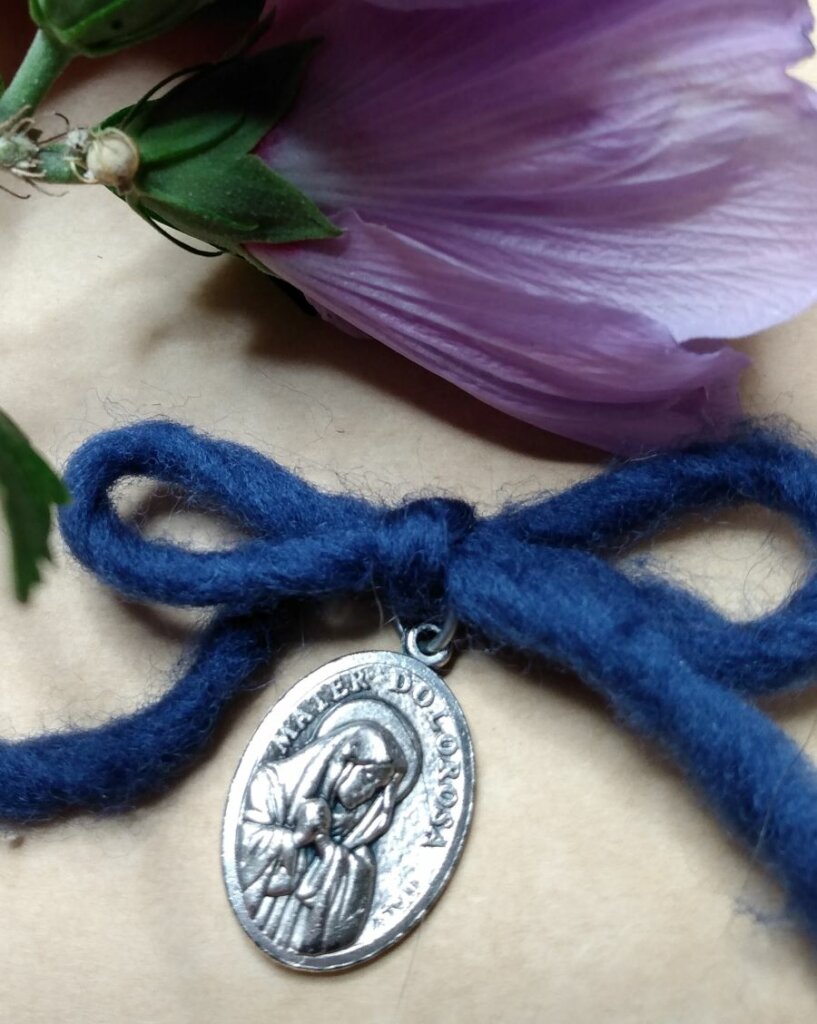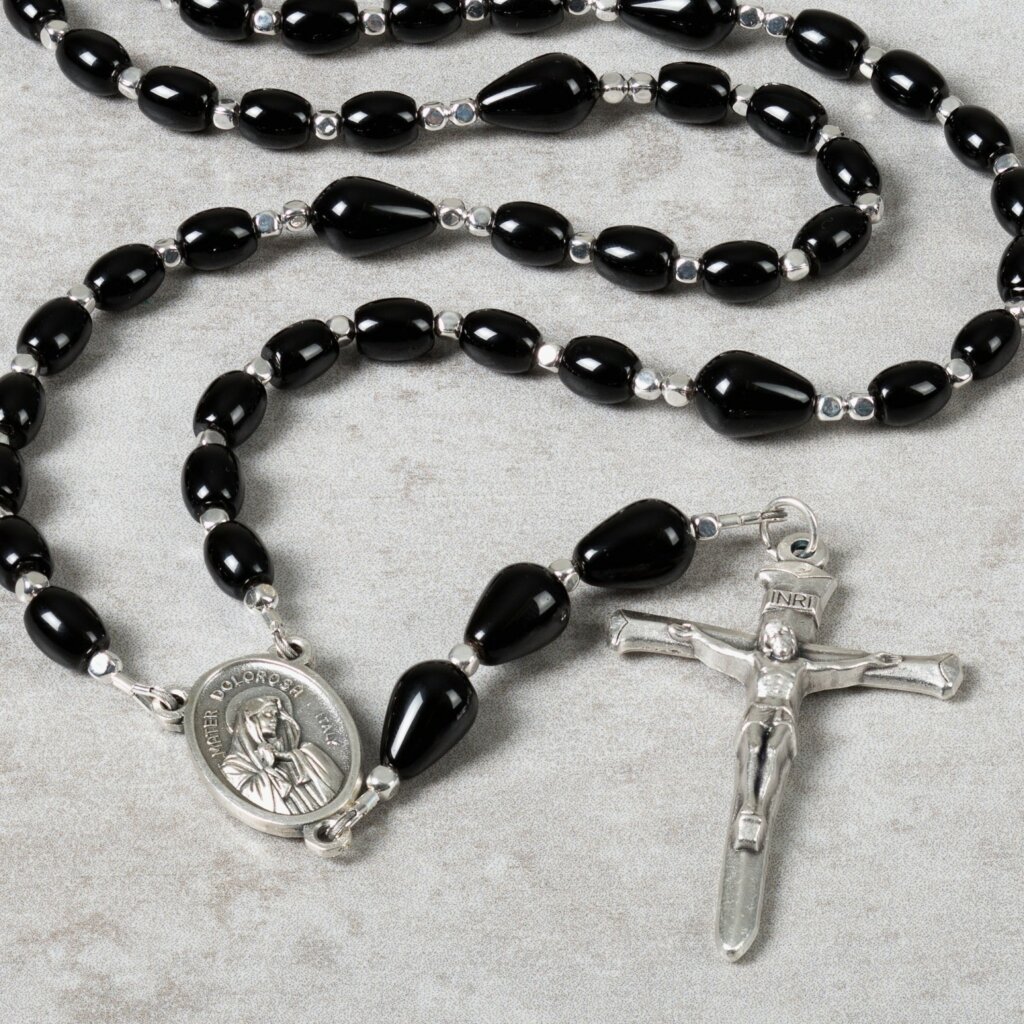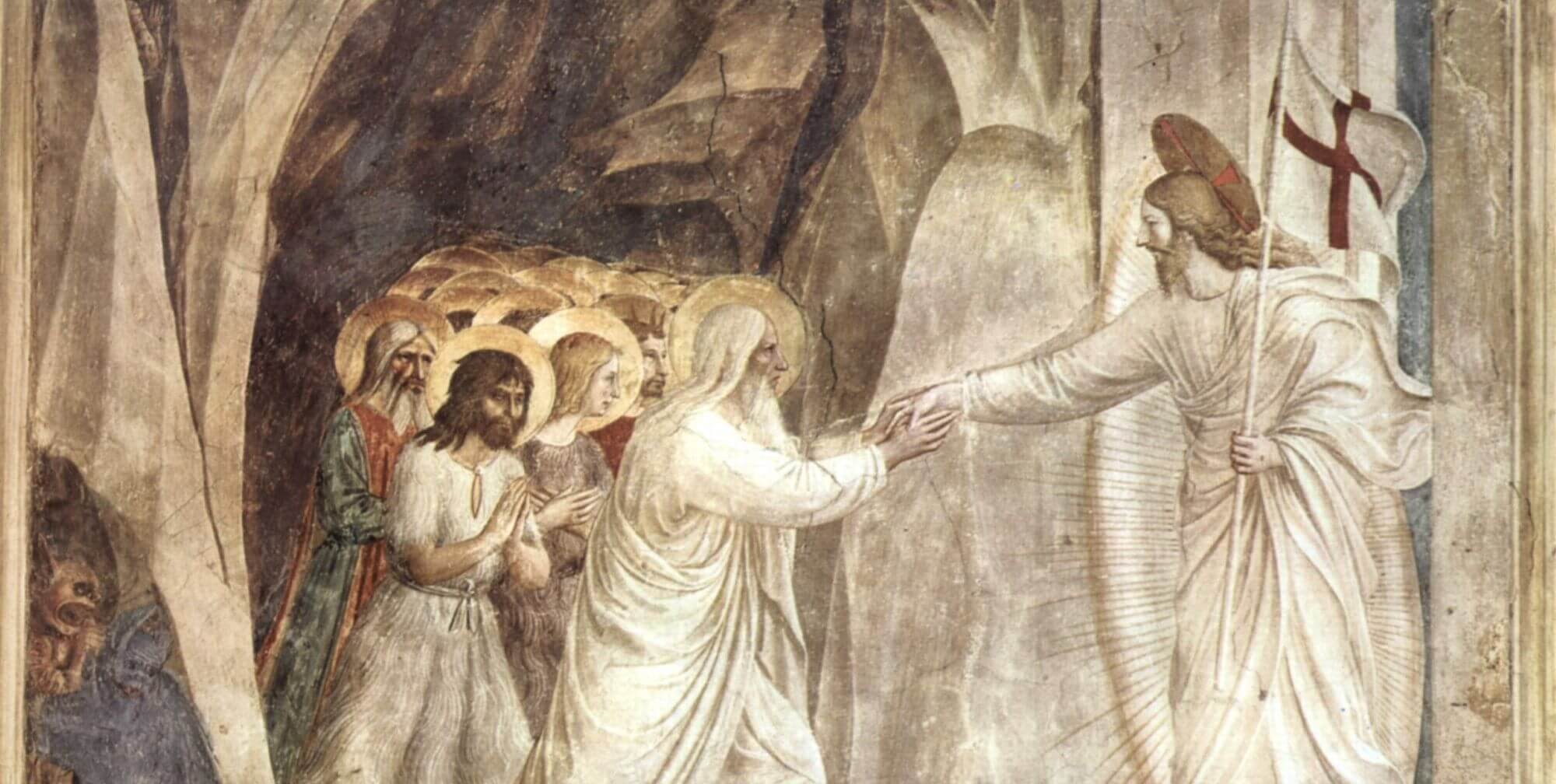
Offer your grieving heart to the Blessed Mother who endured such anguish; she understands a broken heart better than any human and embodies empathy for all those who suffer.
One memory of my mother’s death replays in my mind when I think of that warm fall day in October. Hesitating on the landing of my parents’ stairway, I heard my younger brother, Tom, and the mortician talking. My mother, Sharon, had just passed away from cancer. She didn’t celebrate her 70th birthday.

Frozen on the stairs, I heard the mortician murmur in surprise, “Oh, this is my organist! She sometimes played for funerals at St. James. I remember she always had such beautiful skin.”
Hearing him speak of my mother’s complexion surprised me, and a rush of sadness came over me. The brisk, sharp sound of the zipper closing on the body bag offered a painful realization that I would miss seeing my mom’s face. It’s true. She did have skin like a newly opened compact of ivory-hued makeup, but I hadn’t contemplated this aspect of my mom until I heard his words.
Months and then years went by and I still mourned the loss of my mother, who died in 2011. Adding to that pain was the loss of my dad to cancer in 2014. Besides daily Mass, I looked to the Blessed Mother for consolation. I especially felt a kinship to her under the title of Our Lady of Sorrows. Whenever I gazed at the Mother of Sorrow in sacred art, with seven daggers piercing her tender Heart, I knew she knew my pain.
She Knows a Mother’s Anguish
Our Lady of Sorrows gives those who grieve the courage to bear loss. Imagining ourselves standing with Mary at the foot of the Cross, we can unite our suffering with hers.
Fr. Caleb Vogel, Vicar General for Clergy and Parishes for the Diocese of Boise, Idaho, adds, “Mary shared in the sufferings of Christ in a way that nobody else possibly could. And yet she’s fully redeemed from all of that, [which offers us] a great sign of hope for us as Christians.”

(photo credit: Stanislav Traykov/CC BY-SA 3.0)
Mothers who have lost a child will especially find consolation in Our Lady of Sorrows. Fr. Vogel looks to the Stabat Mater, the 13th-century hymn to Mary portraying her suffering at the foot of the Cross, of which there are now over 300 compositions.
“It has those riveting verses: ‘Who could endure what you have endured? Who has felt what you have felt?’”
He adds, “Nobody knows suffering like a mother.”

For six years, on the Feast of Our Lady of Sorrows, Fr. Vogel offered a special Mass for Parents Grieving the Loss of a Child at my parish, St. Paul’s Catholic Church in Nampa, ID. He witnessed how the Mass and contemplating Mother Mary’s pain in losing her Son offered tremendous consolation for parents.
“For people who have lost a child—or just death in general—there’s the immediacy. You have the funeral, and everybody is gathered around you. There are people who are praying for you, loving you, bringing meals [to help you through the pain].”
Then time moves on, and so do friends and family members, but the parents still hold on to the sorrow and pain.
“It’s a silent suffering, and it’s something that people rarely talk about,” he says. “And so to have a Mass where people come together and say, ‘I lost my child, and I’m going to unite my suffering with the Mother of Sorrows’—who understands more than anyone the loss of a child—there’s an acknowledgment of their sorrow and their pain.”
He adds, “Parents have somebody in the halls of the saints, our Blessed Mother, the highest of them all who understands, can truly empathize with them. She understands more than anybody the unjust loss of a child.”
The Deepest Pain for a Parent
On October 6th, 2020, Nicole Balderson’s nineteen-year-old son, Ian, took his own life. I recall speaking to Nicole after daily Mass at St. Paul’s the day after Ian died. The mother of seven was reeling from the nightmare. I couldn’t imagine what she was going through, and I admired Nicole for turning to God in her need rather than blaming Him. She left our conversation to spend some time in Adoration at our parish’s lovely chapel.
Nicole recently shared with me what happened to her in the chapel. She told me that she entered the Adoration chapel and sat on a wooden bench in the back. Usually she’d choose a seat with a kneeler, but this time, she sat on the bench.
“I was a hot mess, and I happened to glance over, and there was a card with a photograph of the Pietà that said, ‘Pray the Rosary Daily,’ and on the back, it said, ‘Feast Days for Mary, Mother of Sorrow—Friday before Good Friday and September 15th.’ It also had the [list of] Seven Sorrows along with a blessed medal of Our Lady of Sorrows tied to it.”

Nicole took the medal, which had an image of the Savior on the flip side, and fastened it to her Brown Scapular. She had already long felt that the Blessed Mother was looking after her. When she was 16, she ran away from home, and her mom, not knowing what to do, entrusted Nicole to Mary’s care. Her mom’s prayers must have worked because when Nicole was 23, she joined the Legion of Mary. She worked at the parish level to spread devotion to Mary Immaculate, Mediatrix of All Graces, desiring to bring people to Jesus through His Mother.
“When I saw the medal, I figured it was her,” she shared. “Like, here you go…‘you are supposed to have this,’ which I don’t think was a chance occurrence.”
It’s been almost three years since Ian died. The prayer card Nicole found sits on her desk, and the Our Lady of Sorrows medal remains pinned to her scapular. The pain of losing her son sometimes feels like it is getting better, and other times, it feels fresh. Nicole’s incredible trust in the Lord and reliance on Mary help her through those times.
Holy Souls Connection
Mary not only thinks of the needs of the living, but also cares for the Church Suffering—the Holy Souls in Purgatory. I cannot contemplate the September 15th feast of Our Lady of Sorrows without thinking of the Holy Souls in Purgatory. Dubbed the “Purgatory Lady” because of the numerous books she has written on the subject, Susan Tassone agrees. “The love of Our Lady’s sorrowful heart embraces those in Purgatory. She is the loving mother of the Holy Souls.”
Our Lady, called the “Comforter of the Afflicted,” feels compassion for the Holy Souls.
“She loves them. And like the tragic separation from her Son on the cross, for a short time, Mary has lost the souls to Purgatory, which she sees separated from Heaven, from her Son, and from herself […],” says Tassone, who has written several books on devotion to the Holy Souls, including a newly-released children’s book called New Friends Now and Forever: A Story About the Holy Souls.

by Juan Francisco de Aguilera
The Feast of Our Lady of Sorrows reminds us not to forget to pray for the dearly departed—and the dying—and to ask Mary to ease their suffering.
“Remembering the words of her Son when He said that even a cup of water in His name would be rewarded with the joy of heaven,” she points out. “These souls thirst desperately for God, and Our Lady is their helper and comforter.”
A few days before my mom died, I promised her that I would never stop praying for her soul. My kids and I have kept that promise, including intentions for her and my dad in our nightly rosary. Those prayers helped me to heal and are a way for me to stay connected to my parents. They are also a way for my three youngest children to remember their grandparents, who died when they were little.
I am not the only one who feels the benefits of spiritual practices. Emotions and Religiosity: A Psychological Investigation of Participants’ Experience in the Procession of ‘Our Lady of Sorrows’ by Ian Diacono found a positive correlation between religiosity and emotional well-being. Religious practices such as church attendance and participating in religious activities improve a person’s mental state. He also found that religious people have higher emotional intelligence, which encompasses the ability to regulate emotions and empathize with the people around them.
History of the Our Lady of Sorrows
The Feast of Our Lady of Sorrows always falls on September 15th, following the Feast of the Exaltation of the Holy Cross. The Gospels speak of Mary’s suffering, most notably in Luke 2:35 at the Presentation of Jesus at the Temple, when Simeon tells her: “…and you yourself a sword will pierce.”

According to the University of Dayton, the celebration and veneration of Mary’s Sorrows dates back to the 4th century. The devotion grew over the centuries with St. Ambrose (339-397), and later St. Anselm (1033-1109) and St. Bernard (1090-1153), meditating and preaching about Mary’s Sorrows.
In the 13th century, the Servite Order, founded in 1233 in Florence, Italy, dedicated themselves to Our Lady of Sorrows at the request of the Blessed Mother, who appeared to seven men on two occasions. In the 1600s, the Servites created the Seven Sorrows Rosary—also referred to as the Servite Rosary—as a way to honor the Virgin Mary and promote the practice of meditating on her trials, which include:
1. The prophecy of Simeon (Lk 2:34-35)
2. The flight into Egypt (Mt 2:13-21)
3. The loss of Jesus for three days (Lk 2:41-50)
4. The ascent to Calvary (Jn 19:17)
5. The Crucifixion and death of Jesus (Jn 19:18-30)
6. Jesus taken down from the Cross (Jn 19:31-38)
7. Jesus laid in the tomb (Jn 19:39-42)
Fr. Frank Falco, O.S.M., Director of Our Lady of Sorrows Basilica National Shrine in Chicago, said people pray the Servite Rosary because “it touches their hearts, especially when they’ve experienced sorrow in their life.”

Fr. Falco laments that many Catholics don’t know about the Servite Rosary—also called the Seven Dolors Rosary—because Catholics are only taught the Dominican Rosary.
“What makes the Servite Rosary interesting is that it’s scripturally based on the New Testament, whereas most of the devotions to the Blessed Mother are related to apparitions.”
Today, meditating on the Sorrowful Mother’s Seven Dolors may have fallen out of popularity, but in 1937 it caught on like wildfire in Chicago. Servite Father James M. Keane (1901-1975) wrote a novena honoring the Seven Sorrows of Mary for public recitation and organized it to be said at Our Lady of Sorrows Church (now Basilica) in Chicago.

“The novena was only supposed to be for nine days,” Fr. Falco says, “[but] it was so popular that it lasted for over a year. There were 70,000 to 80,000 people [attending] every Friday to pray the Novena at Our Lady of Sorrows.”
Eventually, over 2,000 churches and convents worldwide held Our Lady of Sorrows Novena services.
“It touched a lot of people’s lives, especially during the depression and war years,” he says. “Today, the Our Lady Sorrows Novena is no longer a public devotion at Our Lady of Sorrows Basilica, only a private devotion.”
Reviving Devotion to Our Lady of Sorrows
Can you imagine if Catholic families began a grassroots effort to reignite the Our Lady Sorrows Novena?

Public novenas to Our Lady of Sorrows are designated only for churches and chapels in which the Via Matris (The Way of Our Sorrowful Mother) has been canonically erected. But there are various private versions online you can pray with your family and friends, or you can download a free, beautifully-illustrated, 11-page meditation booklet from EWTN called The Seven Sorrows of the Blessed Virgin Mary. The Catholic Company also offers many chaplets, meditation books, and other items dedicated to Our Lady of Sorrows.
Our Lady of Sorrows, pray for us!







